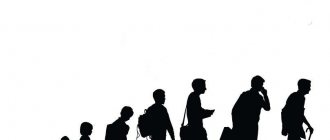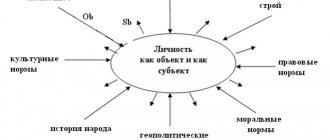What is mass psychology?
Mass psychology is a field of psychology that studies social consciousness, the characteristics of behavior and thinking of a large group of people united by common views and a common emotional state, driven by common interests, and also performing the same actions over a short period of time. Unlike the individual psychology of a particular person, the mass of people is characterized by a mental community. Therefore, mass psychology is based on the opposition of an individual outside the mass of people to himself, who is inside the crowd.
A person exists on his own, makes his choice, and adjusts his behavior consciously. But everything changes when he is not alone, but in a crowd. Even without psychological pressure from the outside, he perceives the behavior of others, becomes infected by it, obeys and follows it. Individual consciousness seems to dissolve, disappear, and become part of the collective unconscious. The question of why the psyche of an individual person reacts so sharply to the presence of many people remains open and fundamentally important for psychologists, sociologists, cultural scientists, philosophers, political scientists, lawyers, and security officials.
The scientific study of crowd psychology began after the events of the French Revolution of 1789. A century later, French psychologist Gustave Le Bon became interested in the motives of the participants in the uprising. From a scientist's point of view, their behavior was irrational, which is what aroused such interest. Later, Le Bon had comrades and followers - Sigmund Freud, Carl Jung, Vladimir Bekhterev. A new direction has emerged in psychology - “psychology of mass behavior”, which in the 60-70s of the 20th century developed into “psychology of collective behavior”.
Mass psychology studies what happens to a person the moment he finds himself inside a crowd. In addition, psychologists and sociologists research:
- How the mood, thinking, and emotional state of the crowd is created and changed.
- Motives, ideas, stereotypes of the crowd.
- What the crowd is capable of and what it strives for.
- Interaction between the individual and the masses.
- Spontaneous aggression, incidents, riots associated with mass consciousness.
- Cultural, ethnic, national characteristics of crowd behavior.
- How is the “spiritual” unity of the mass formed – the so-called “soul of the crowd”.
Take the self-esteem test
Identification
Freud develops a mechanism of mass formation based on the principles of identification, as the earliest manifestations of an emotional connection with another person. His findings were supported by the following identification features:
- The emergence of an emotional connection with the object;
- Replacement of libidinal connection;
- The possibility of identification with each newly noticed commonality with a person who is not the object of sexual instincts.
If we take as a basis the initial introductions offered by the author regarding the features of identification, we can agree with the conclusions he formulated that identification is a mechanism for the formation of masses and the formation of emotional connections in it between objects of such masses.
Freud highlighted the difference between identification with the father (who one wants to be) and the object choice of the father (what one wants to possess), while highlighting the ambivalence of feelings: from expressions of tenderness to the desire for elimination. Examples of such identification are currently among the typical issues being worked through when a psychoanalyst works with patients.
Freud also considered identification in the neurotic formation of symptoms and said that identification is devoid of an object relationship to the person being copied (mental infection). The author's opinion regarding mental infection is difficult to comment on in any way, since he does not provide a more detailed chain of reasoning on the basis of which this conclusion was made.
Psychology of the crowd and the collective: similarities and differences.
Do you want to make better decisions, find your ideal career, realize your maximum potential and receive instructions for individual development?
?
All this can be done using the Human Design
. Build your map and get basic decryptions for free.
Initially, a crowd means a large (or not so large) gathering of people united by one place, a common interest and emotional state. But the crowd does not have a single goal that would require organization, discipline, and coordinated actions. Therefore, a crowd is called any extras: from a group of passers-by who stopped to watch a street magician perform, to an aggressive mass of people running away from the bulls at a bullfight. In some cases, mass behavior can be rational - for example, a meeting of city residents to resolve issues of concern.
Like any social phenomenon, a crowd can be defined on various grounds:
- By type of management : spontaneous, driven, organized.
- By type of organization : occasional (random, associated with curiosity); conventional (collected on the basis of interest); expressive or ecstatic (collected to express an attitude towards an event); active (distinguished by the presence of active actions).
- By degree of organization : heterogeneous (street), homogeneous (sects, castes, classes).
Panic and aggressively acting crowds, which lead to riots and clashes, are considered relevant, but the most difficult to study.
Collective behavior differs from mass behavior. They unite into a collective in the name of a common goal - eliminating injustice (ethnic, gender, social, religious) in society. Moreover, participants do not have to meet regularly. They can act individually (give lectures, collect donations) and gather together from time to time (hold rallies, sign petitions).
Psychologists and anthropologists describe the mechanism of crowd formation as evolutionary regression. When there is a large crowd of people, most of them revive the lower layers of the most ancient part of the cerebral cortex. The achievements of civilization are blocked, the psyche returns to the early stage of evolution, and consciousness resembles the primitive consciousness of primitive ancestors.
Clarification of the mechanism of hypnosis
After clarifying the mechanisms of mass formation and the basics of hypnosis, Freud demonstrates how it functions in a mass using the example of a primitive horde:
- Freud's starting premises:
- The mass is a newly revived primitive horde;
- Mass psychology is the oldest psychology of humanity;
- Love limits narcissism;
- The forefather forces his “sons” to abstinence, that is, to mass psychology;
- The hypnotist steals the will of the subject, has the power of animal magnetism, which is taboo among primitive peoples.
- Freud's explanation of the mechanism of hypnosis using the example of a horde:
- Demonstration of love. In the primitive horde, the illusion is maintained that the leader loves everyone in an even and fair manner (an idealistic reworking of the conditions of the primitive horde: all sons knew that they were equally persecuted by their father and were equally afraid of him).
- Concentration/stealing will. The hypnotist, like the leader of the horde, demands to look into his eyes, which is difficult to bear. He avoids directing the subject's conscious thinking towards his intentions. The subject concentrates his attention on the hypnotist, establishing a connection with him and a readiness to endure internal processes.
- Awakening fear of the parental figure. During hypnosis, the subject awakens part of his archaic heritage, which also manifested itself in relation to his parents. At the same time, the subject’s idea of a super-powerful and dangerous person came to life. A similar attitude of the primitive man of the horde to the forefather.
Based on the conclusions made earlier, I would like to note that Freud explains the compulsory nature of mass formation, incl. the origin of the primitive horde with the help of hypnosis (suggestion), based not on mental work, but on an erotic connection, which does not coincide with the conclusions made earlier by his predecessors. However, the logic of reasoning and the presentation of evidence allows us to agree with the author’s opinion.
Why does the crowd influence us?
What draws us into the crowd is also a deep-seated need - from time to time to free ourselves from the burden of a social role, restrictions, and norms of behavior. I want to relax, shout at a rock concert, yell at a stadium, or disappear among the people at a fair. These ancient mechanisms of mass recreation are still alive today. They help relieve tension, relieve excess aggression, “break away” from responsibilities and be among people.
But on the other hand, the crowd has its drawbacks. Once inside a large crowd of people, a person seems to be floating on a river with a fast current. It seems that thoughts, body, will remain, but there is no way to manifest them.
Being inside the human flow, the individual:
- “Forgets” about cultural, ethical or moral norms, stops analyzing his behavior.
- He commits actions that he would never do “in his right mind”: he commits cruelty, commits murder.
- Submits to general sameness and even stops resisting.
- Loses freedom of action and sense of responsibility.
- Instantly “absorbs” other people’s emotions, which prevail over reason and force them to act impulsively.
- Stops communicating verbally with individuals.
- Imitates the general movements of the leader or the majority of the crowd.
Sigmund Freud described two phenomena in the characteristics of crowds that explain this behavior. This is “infectivity”, which is considered to be hypnosis, and “suggestibility”, when the majority reacts not to argumentation, but to slogans and individual symbols. The power of the crowd does not lie in unanimity, but in the “avalanche effect.” As soon as it is possible to influence some people, the rest begin to shout, wave slogans, or move purely by inertia. Skilled manipulators take advantage of this.
Take a self-confidence test
Direction use
| Organizers |
More trainers 14
Consultants Alla Anatolyevna Shelyapina (Moscow), Arie Gottsdanker (Moscow), Maria Chapovski (Moscow), Olga Anatolyevna Semizdralova (Moscow), Svetlana Ilyinichna Zdrazhevskaya (Moscow), Yana Vyacheslavovna Bolotova (Moscow), Yana Gennadyevna Peredernina (Moscow), Natalya Nikolaevna Melnikova (Chelyabinsk), Tatyana Emlina (Caucasian Mineral Waters), Tamara Yuryevna Smirnova (Yaroslavl), Sergey Sergeevich Papulov (Tomsk), Svetlana Olegovna Larionova (Ekaterinburg), Tatyana Nikolaevna Silaeva (Naberezhnye Chelny), Natalia Dantsova (Rostov-on-Don ), Lyubov Anatolyevna LSB (Krasnoyarsk), Maria-Marichka Vedunya (Irkutsk), Maria Vladimirovna Mazhara (Saratov), Dina Berezina (Ulan-Ude), Daniel Arturovich Art (St. Petersburg), Valentina Alekseevna Semiklit (Perm).More consultants 2
How to protect yourself from manipulation?
An individual ceases to control his behavior as soon as he gets into the crowd and becomes himself again as soon as he leaves it. You can fully realize your potential, reveal your talent, and bring benefits only through individual activity. But there is a problem: one in the field is not a warrior. There is only one way out - do not succumb to outside manipulation.
Forewarned is forearmed. Here are 9 popular psychological techniques that subtly but surely influence people.
Presupposition.
This is one of the most used NLP models, which allows speech to create “a reality in which only the desired behavior options exist.” Presupposition helps to gently convince a person that something will definitely happen.
For example, a politician agitates voters: “When I am president, I will do...”. And he doesn’t even discuss the option that this won’t happen.
Flattery.
A simple but effective “below the belt” technique, with which the manipulator tries to put the other in a good mood and use it to his advantage. Here we work on the opponent’s self-esteem: compliments, encouragement, words of gratitude.
For example, a manager convinces employees to go to work on a day off: “I know that you are responsible workers, so you can spend your day off and do urgent work.”
Pre-selection.
It works on the principle: choose the lesser of two evils. On the one hand, there are no prohibitions and there is the right to choose. But on the other hand, there are no other answer options other than those proposed.
For example, in advertising we are asked: “Do you choose Fanta or Sprite (burger or cheeseburger)?” Although both brands belong to the same manufacturing company.
Inspiration.
Inspiration helps you work tirelessly, make discoveries, and believe in your superpowers. So when manipulators want to persuade someone to achieve a feat, they organize inspiration for him.
For example, before a battle, the commander tells the soldiers: “What you are doing is necessary! You will succeed! Everything for peace on earth!”
Emotional attack.
Playing on emotions is a simple way to get the right actions from employees, relatives, and friends. This is repeated repetition of the same demands, a change in intonation, an attempt to promote feelings of guilt.
For example, a teacher shames the class: “I treated you like adults, but you let me down. Do you know how the director scolded me because of you?”
Social proof.
The so-called herd instinct is remembered by most residents of the Soviet Union, who stood in line only because it was a symbol of scarcity. “If everyone takes it, it means it’s a good thing,” thinks a person who does not want or does not have time to understand the situation.
For example, when people want to choose from a large number of gadget models, they rely on ratings and reviews. And they don’t even think that reviews are written by “their” employees from the manufacturing company.
The principle of mutual exchange.
The rule says: a person needs to return good for good. And since any obligations are depressing, you want to get rid of them as quickly as possible. Skilled manipulators take advantage of this - they provide a small service and wait for a response.
For example, religious sectarians hand out free literature on the street, and in return ask to listen to their instructions.
Motivation by fear.
Fear is a powerful human emotion and a sure-fire motivator. Therefore, in order to force a person to do something, you need to scare him properly “in advance”: talk about a future car breakdown or warn him about an article for theft.
For example, the work of insurance companies is based on intimidating people - the more intimidating examples are given, the more often insurance policies are purchased.
Le Bon and his characterization of the mass soul
Let us once again clarify the state of affairs: if psychology, which observes the inclinations and impulses, motives and intentions of an individual person, right down to his actions and relationships with the people closest to him, completely solved its problem and clarified all these relationships, then it would suddenly would be faced with a new unresolved problem. Psychology would have to explain the amazing fact that this individual, who has become understandable to it, under a certain condition, feels, thinks and acts completely differently than could be expected from him, and this condition is his inclusion in the human crowd, which has acquired the property of a “psychological mass.” But what is a “mass”, how does it acquire the ability to so decisively influence the mental life of an individual person, and what is the mental change to which it forces a person?
The task of theoretical mass psychology is to answer these three questions.
Le Bon says: “The strangest thing about a psychological mass is this: whatever the kind of individuals composing it, no matter how similar or dissimilar their lifestyle, occupation, character and degree of intelligence, but by the mere fact of their transformation into a mass they acquire a collective soul, due to which they feel, think and act completely differently than each of them individually felt, thought and acted. There are ideas and feelings that manifest themselves or turn into action only in individuals united in masses. A psychological mass is an arbitrary being, which consists of heterogeneous elements united for a moment, just as the cells of an organism by their union create a new being with qualities completely different from those of individual cells.”
“It is easy to establish the degree of difference between an individual belonging to the mass and an isolated individual; it is less easy to reveal the reasons for this difference.
In order to even approximately find these reasons, we must first of all remember the fact established by modern psychology, namely, that not only in organic life, but also in intellectual functions, unconscious phenomena play a predominant role. The conscious mental life represents only a rather insignificant part of the unconscious mental life. The finest analysis and keenest observation can reveal only a small number of conscious motives of mental life. Our conscious actions come from an unconscious substrate created especially by the influence of heredity. This substrate contains countless traces of the ancestors, traces from which the racial soul is created. Behind the motives of our actions, which we do not admit, there are undoubtedly secret reasons that we do not admit, and behind them there are even more secret ones, which we do not even know. Most of our everyday actions are only the influence of hidden motives that we do not notice.”
In the mass, according to Le Bon, the individual achievements of individual people are erased, and new qualities arise that they did not possess.
“The first of the reasons is that in a mass, by virtue of the mere fact of his multitude, the individual experiences a feeling of irresistible power, allowing him to indulge in primal urges that, if he were alone, he would be forced to curb. There is even less reason to curb them, since with the anonymity, and thus the irresponsibility of the masses, the sense of responsibility, which always restrains the individual, completely disappears.”
“The second reason, infectiousness, also contributes to the manifestation of special signs among the masses and the determination of their direction. Infectivity is an easily ascertainable but inexplicable phenomenon that should be classified as a hypnotic phenomenon, which we will immediately begin to study. In a crowd, every action, every feeling is contagious, and to such a strong degree that the individual very easily sacrifices his personal interest in favor of the general interest. This is a property completely opposite to his nature, which a person is capable of only as an integral part of the mass.”
“The third, and moreover the most important, reason determines in individuals united in a mass special qualities that are completely opposite to the qualities of an isolated individual. I mean suggestibility, and the mentioned infectiousness is only its consequence.
To understand this phenomenon, it is appropriate to recall new discoveries in physiology. We now know that by various procedures a man can be brought into such a state that, after losing his entire conscious personality, he obeys all the suggestions of the person who deprived him of the consciousness of his personality, and that he commits acts most blatantly contrary to his character and skills. And the most careful observations have shown that an individual, who remains for some time in the bosom of an active mass, soon falls, as a result of radiation emanating from it, or for some other unknown reason, into a special state very close to the “enchantment” that takes over hypnotized under the influence of the hypnotist... The conscious personality is completely lost, the will and ability to discriminate are absent, all feelings and thoughts are oriented in the direction indicated by the hypnotist.
This is approximately the state of an individual belonging to a psychological mass. He is no longer aware of his actions. Both in a person under hypnosis and in him certain abilities can be withdrawn, while others can be brought to a degree of greatest intensity. Under the influence of suggestion, he will, in an irresistible impulse, begin to perform certain actions. And this frenzy among the masses is even more irresistible than among the hypnotized, for the suggestion, which is equal for all individuals, increases due to interaction.
Consequently, the main distinguishing features of an individual found in a mass are the following: the disappearance of the conscious personality, the predominance of the unconscious personality, the orientation of thoughts and feelings in the same direction due to suggestion and infection, the tendency to urgently implement inspired ideas. The individual is no longer himself, he has become a weak-willed automaton.”
“In addition, by the mere fact of belonging to the organized masses, a person descends several steps lower on the ladder of civilization. Being an individual, he was perhaps an educated individual, but in the mass he is a barbarian, i.e. a creature driven by primal urges. He has the spontaneity, impetuosity, wildness, and also the enthusiasm and heroism of primitive creatures."
Le Bon's thoughts on the leaders of the masses are presented in a less comprehensive manner, and the patterns remain insufficiently clarified. He thinks that as soon as living beings are gathered together in a certain number, no matter whether it is a herd of animals or a human crowd, they instinctively place themselves under the authority of the head. The masses are an obedient herd that cannot live without a master. She has such a thirst for submission that she instinctively submits to anyone who calls himself her master.
Le Bon distinguishes between acquired, or artificial, and personal prestige. The first, in the case of people, is assigned due to name, wealth, reputation, in the case of views, works of art, etc. through tradition. Since in all cases this concerns the past, it will help little in understanding this mysterious influence. Few people have personal prestige, and through it they become leaders. Prestige subjugates them all and everything is as if under the influence of a magic spell. Every prestige depends, however, on success and is lost after failure.
Notes
- Dodeltsev R. F.
Psychotherapist in the role of culturologist and sociopsychologist // Sigmund Freud. Totem and taboo / trans. with him. R. F. Dodeltseva. - St. Petersburg. : ABC-Atticus, 2021. - 14 p. — ISBN 978-5-389-10137-1. - Dodeltsev R.F.
Notes on Mass Psychology and Self Analysis // Sigmund Freud. Totem and taboo / trans. with him. R.F. Dodeltseva. - St. Petersburg. : Azbuka-Atticus, 2017. - 313 p. — ISBN 978-5-389-10137-1. - Dodeltsev R.F.
Notes on Mass Psychology and Self Analysis // Sigmund Freud. Totem and taboo / trans. with him. R.F. Dodeltseva. - St. Petersburg. : Azbuka-Atticus, 2017. - 314 p. — ISBN 978-5-389-10137-1. - Dodeltsev R.F.
Psychotherapist as a culturologist and sociopsychologist // Sigmund Freud. Totem and taboo / trans. with him. R.F. Dodeltseva. - St. Petersburg. : ABC-Atticus, 2021. - 15 p. — ISBN 978-5-389-10137-1. - Dodeltsev R.F.
Psychotherapist as a culturologist and sociopsychologist // Sigmund Freud. Totem and taboo / trans. with him. R.F. Dodeltseva. - St. Petersburg. : ABC-Atticus, 2021. - 16 p. — ISBN 978-5-389-10137-1. - Freud Z.
Psychology of masses and analysis of the Self // Sigmund Freud. Totem and taboo / trans. with him. R.F. Dodeltseva. - St. Petersburg. : ABC-Atticus, 2021. - 247 p. — ISBN 978-5-389-10137-1. - Dodeltsev R.F.
Psychotherapist as a culturologist and sociopsychologist // Sigmund Freud. Totem and taboo / trans. with him. R.F. Dodeltseva. - St. Petersburg. : ABC-Atticus, 2021. - 16 p. — ISBN 978-5-389-10137-1. - Dodeltsev R.F.
Psychotherapist as a culturologist and sociopsychologist // Sigmund Freud. Totem and taboo / trans. with him. R.F. Dodeltseva. - St. Petersburg. : ABC-Atticus, 2021. - 17 p. — ISBN 978-5-389-10137-1. - Dodeltsev R.F.
Psychotherapist as a culturologist and sociopsychologist // Sigmund Freud. Totem and taboo / trans. with him. R.F. Dodeltseva. - St. Petersburg. : ABC-Atticus, 2021. - 17 p. — ISBN 978-5-389-10137-1. - Freud Z.
Psychology of masses and analysis of the Self // Sigmund Freud. Totem and taboo / trans. with him. R.F. Dodeltseva. - St. Petersburg. : ABC-Atticus, 2021. - 269-270 p. — ISBN 978-5-389-10137-1. - ↑ Dodeltsev R.F.
Psychotherapist as a culturologist and sociopsychologist // Sigmund Freud. Totem and taboo / trans. with him. R.F. Dodeltseva. - St. Petersburg. : ABC-Atticus, 2021. - 18 p. — ISBN 978-5-389-10137-1. - Dodeltsev R.F.
Psychotherapist as a culturologist and sociopsychologist // Sigmund Freud. Totem and taboo / trans. with him. R.F. Dodeltseva. - St. Petersburg. : ABC-Atticus, 2021. - 19 p. — ISBN 978-5-389-10137-1. - Serdtseva N.
Freud. Principles. Ideas. Fate. - M.: Eksmo, 2021. - (Philosophical handwriting). — 154 p. — ISBN 978-5-04-095334-9. - Serdtseva N.
Freud. Principles. Ideas. Fate. - M.: Eksmo, 2021. - (Philosophical handwriting). — 157 p. — ISBN 978-5-04-095334-9. - Serdtseva N.
Freud. Principles. Ideas. Fate. - M.: Eksmo, 2021. - (Philosophical handwriting). — 137-138 p. — ISBN 978-5-04-095334-9. - Dodeltsev R.F.
Psychotherapist as a culturologist and sociopsychologist // Sigmund Freud. Totem and taboo / trans. with him. R.F. Dodeltseva. - St. Petersburg. : ABC-Atticus, 2021. - 14 p. — ISBN 978-5-389-10137-1. - ↑ Dodeltsev R.F.
Psychotherapist as a culturologist and sociopsychologist // Sigmund Freud. Totem and taboo / trans. with him. R.F. Dodeltseva. - St. Petersburg. : ABC-Atticus, 2021. - 14 p. — ISBN 978-5-389-10137-1. - Freud Z.
Psychology of masses and analysis of the Self // Sigmund Freud. Totem and taboo / trans. with him. R.F. Dodeltseva. - St. Petersburg. : ABC-Atticus, 2021. - 221 p. — ISBN 978-5-389-10137-1.









